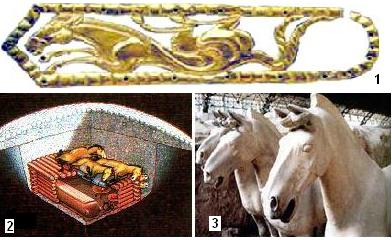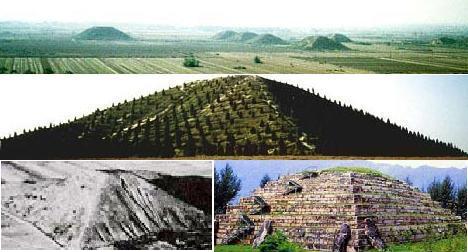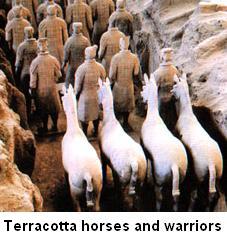|
The cult of sacrificing horses after a dead leader is of
Asiatic origin practiced by the early Uighur tribes, as
discussed in several previous chapters. In order to
differentiate a regular live-horse from a sacrificed one, the
Asiatic cultures depicted the hind part of the sacrificed
animal being contorted upside down. This symbolism meant that
the horse –or any sacrificed animal- lost its physical normal
shape and became a spirit, ready to run in the underworld.
Actually the sacrificed animals were killed with a single blow
on the forehead, which resulted in sudden painless death.
Figures of contorted horses and elks have been found in
several Altaic kurgans. The elk tattoo shown in Chapter 4
exhibits this symbolism of contorting hind legs. The golden
plaque (Picture 1 below) shows a contorted horse that adorned
the knob of the dagger of the “Golden man” discussed in
Chapter 22, The Issýk kurgan.
It is clear that such zoomorphic contorted figures were not
intended for simple decorative effect, but were to symbolize
the soul of sacrificed animals, sent to the underworld for
allowing a safe passage to the soul of the dead person.
Picture 2
below is a drawing of the Ukok kurgan mentioned in Ref. 3 of
Chapter 4. Horse remains were found on the top as well as on
the external sides of the wooden burial room.

Protecting
the soul from being devoured by griffins was such a strong
belief in Central Asia that the first emperor who united
China, Qin Shi Huang Di
(259 – 210 BC) ordered a special mausoleum to be built and
horses to be sacrificed after his death. The title “Huang” is
a transformed form of the Turkic “Khang”
as mentioned in Chapter 5,
Climatic changes, a clear indication of the Asiatic
influence on Chinese culture. Qin troops overran the
Han (Khan) state in
236 BC and then proceeded to defeat the Çao (Çay),
Wei (Uy), Çu (Uç),
Yan (Yan) and Qi (Kýyý)
states, all of them belonging to the early Uighur
confederation of loose independent tribes. The names of these
neighboring states are all of Turkic origin, as transcribed in
brackets.
Construction
of the mausoleum of Qin Shi Huang Di started in 247 BC and
lasted until his death. As many as 720,000 workers from across
the country helped construct the tomb. A sacrificial stable
was unearthed some 20 ms from the Qin Mausoleum. This stable
contained 99 sacrificed horses
(1).
Picture 3 above shows a row of terracotta horses from the Qin
Mausoleum. Three trenches, which cover over 20,000 square ms,
hold about 7,000 life-size terracotta horses and armored
warriors.
The original
burial site was 115 ms high and was covered with earth,
forming a medium size pyramidal mound. There are still many
untouched pyramids in China. These pyramidal structures are
man-made hills replacing –or mimicking- the kurgans located at
the high regions of the Altai Mountains. They are all built on
the flat plains of China and are burial sites of previous
local Uighur Kings or early Chinese Emperors, another
indication of the Central Asiatic influence on China. Below we
see some examples of Uighur and / or Chinese pyramids.

The
tradition of knotting the tail of horses is another typical
Central Asiatic influence on the Chinese culture. This
tradition of knotting the tail of horses, kept in the Chinese
army, can be seen in the picture below, showing terracotta
soldiers and horses (2).

The
tradition of burying kings and important leaders of the
society in man-made pyramidal structures, together with
sacrificed horses, went wherever the Asiatic Uighur tribes
migrated.
When ancient
Egyptians pressed south, some 2500 years BC, they found a
culture devoted to the sun-cult which was called
Kush
(“bird” in Turkish). The main cities of this culture were
Jebel Barkal, Napata and Meröe, all of them located between
present Egypt and Sudan on the banks of the upper-Nile river.
In Jebel Barkal and Meröe the tombs of five Kushite kings and
their 70 successors were discovered.
In an
article on Kush, Timothy Kendall says
(3):
Nearby the burial site, the excavators discovered an amazing
horse cemetery. Twenty-five steeds, draped with nets decorated
with cowrie shells and faience and bronze beads had been
interred standing. Horses were introduced to Egypt from the
east and the Kushites raised fine animals coveted even by the
distant Assyrians.
These words give us some hints on the extent of the south-east
expansion of the Uighur tribes discussed in Chapter 18,
Towards Sümer and Elam
(see the map in Chapter 18). |